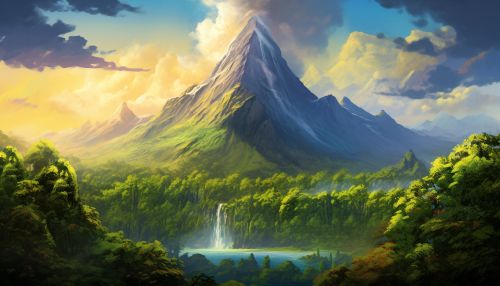Volcano
Introduction
A volcano is a rupture in the crust of a planetary-mass object, such as Earth, that allows hot lava, volcanic ash, and gases to escape from a magma chamber below the surface. They are generally found where tectonic plates are diverging or converging, and most are found underwater. Volcanoes can also form where there is stretching and thinning of the Earth's crust.
Formation
Volcanoes are formed when there is an increase in the geothermal gradient, or the rate at which temperature increases with depth, and the mantle melts to form magma at depth under the Earth's crust. The magma rises through the crust and erupts on the surface. If the magma is too thick, gas bubbles can cause it to explode, creating a volcanic eruption. The magma that has erupted onto the surface is called lava.
Types of Volcanoes
There are several types of volcanoes: Shield volcanoes, Composite volcanoes, Cinder cone volcanoes, and Lava domes. Shield volcanoes are large, broad volcanoes where lava pours out in thin layers, allowing it to travel a far distance. Composite volcanoes are steep-sided volcanoes composed of many layers of volcanic rocks, usually made from high-viscosity lava, ash and rock debris. Cinder cone volcanoes are simple volcanoes which have a bowl-shaped crater at the summit and only grow to about a thousand feet, the most common type of volcano. Lava domes are built by slow eruptions of highly viscous lava.
Volcanic Activity
Volcanic activity refers to the eruption of a volcano. This can involve the release of gas, pyroclastic material, or lava. Volcanic activity is classified by how often a volcano erupts. A volcano can be active, dormant, or extinct. An active volcano is currently erupting or showing signs of imminent eruption. A dormant volcano is not currently erupting, but could erupt again. An extinct volcano has not erupted for a very long time and is unlikely to erupt again.
Volcanic Hazards
Volcanic hazards refer to any potentially dangerous volcanic process (e.g. lava flows, pyroclastic flows, ash fall, pyroclastic surges). These hazards can cause death and destruction, and can affect areas many miles from a volcano. Understanding these hazards and how to mitigate their impact is a key part of volcanology.
Volcanology
Volcanology is the study of volcanoes, lava, magma, and related geological, geophysical and geochemical phenomena. Volcanologists visit volcanoes, especially active ones, to observe volcanic eruptions, collect eruptive products including tephra (such as ash or pumice), rock and lava samples.
See Also


